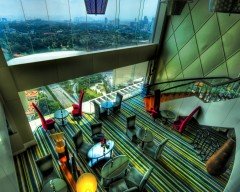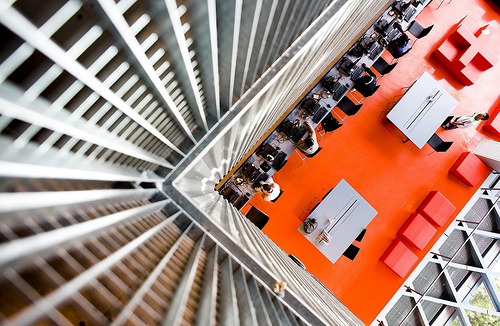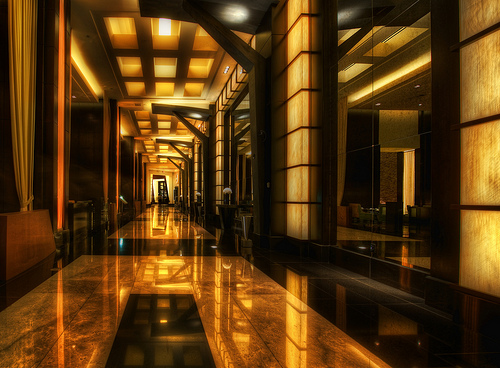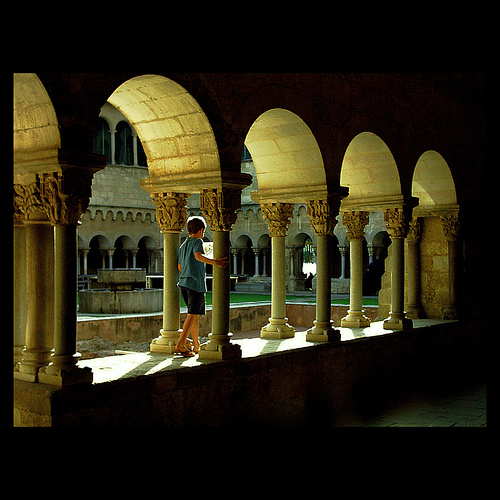
Architecture photography has a lot of scope for commercial purposes like in real-estate business etc. While photographing exteriors requires focus on composition, you have to be particular about lighting when photographing interiors (check out the article on photographing architectural structures here). You have to be particular about the geometry of structures and the presentation of the photographs, especially when you are shooting for commercial purpose. It requires you to be ready with appropriate equipment, proper technique and a few composition tips to get started with taking stunning interior shots.
Equipment
Right equipment at the right time is the key to great photographs. Your camera is not the only thing which matters, especially in case of interior photography, where photographing in low-light and tricking the camera metering is much of a task.
- Tripod: Using a tripod for interior photography comes in handy for making long exposures to compensate for low-light. It also helps in composing the scene well; by optimally accommodating the well-furnished rooms and elegantly designed interiors. If you are not allowed to carry a tripod, as may be the case when photographing public architectures, look for a sturdy surface to help you get sharp images when making a long exposure.
- Lenses: You can make the most of architectural photography by using a variety of lenses which help you in capturing the scene in entirety. The real value of the interiors lies in conveying the immense comfort and immersive lifestyle, including either of the following lenses will help you in portraying the pervasiveness of interiors.
- Wide Angle Lens: Along with providing a wider coverage for interiors, wide angle lenses render the sense of depth in the scene by portraying relative size and distance for all the elements in the scene.
- Fish-Eye Lens: Fish eye lens is an extremely wide angle lens, which results in introducing geometrical distortions, which can sometimes be used to exaggerate the curves and domes of the architectural buildings.
- Perspective Correction Lens: Even though a wide angle lens is good for photographing interiors, a perspective correction lens holds good promises for correcting the geometrical distortions in-camera, which can otherwise be corrected in image editing software as well. Invest in this type of lens only when you are shooting architectures most of the time.
- External Flash Or Strobes: If you are photographing interiors for commercial purpose, using the external flash or perhaps the strobes come in handy for lighting up the interiors well for capturing the fine details beautifully (with proper exposure). The need for one arises owing to the limited intensity of on-camera flash, which fails to properly illuminate a larger area.
Technique
A proper technique helps you get ready for taking ultimate shots. Some of the techniques for getting ready for amazing results for interior photography are:
- Make The Most Of Available Light: Shooting in daylight gives you an opportunity of using the natural lightsallowed through doors, windows, blinds and ventilators. The natural light let in, produces shadows or may get reflected to illuminate the interiors for taking a good shot. On the other hand, the lights from window panes may also trick the camera meter resulting in underexposed or washed off scene. So, the wise thing to do in this scenario is to lit the interiors with artificial lights (if possible); to compliment the natural light and to produce effective results.
- Use Flash: Flash is the best friend of the photographer to indeed help him in making the most from low-ambient light. Bouncing the flash off the walls and window-panes enable you to evenly lit the room and using the fill flash helps you in overriding the effect of primary source of light. The real estate photographers probably use multiple strobes for producing glossy, rich and vivid colors to entice the viewers to attain shelter in the house.
- Cover In Entirety: When photographing the real-estates or interiors of any architectural building, photograph not only the hot-spots, but also include the decors, furnishings, carved patterns and textures, fine details, styling and roofs and ceiling as well. Capturing the details gives a unique identity and attaches value to the architectural interiors.
- Process The Images For Finishing Touch: Unless you are photographing the interiors of the public architectures, you are bound by presenting the photographs in enticing manner. You need to render the shining walls, glossy furnishings and elegant decors to attract the potential buyers to sign a deal with real-estate dealer. To make your real-estate photographs stand out distinct, you need to spend a good time for giving final touches to the photographs during post-processing (by dodging and lighting effects).
Composition / Framing Tips
Once you have the right equipment and you know what you are doing, things become simple. Now, its time to release the shutter; keeping in mind the photographic concept of composition — the heart of the art. Here are some composition tips to help you frame beautiful interior photographs.
- Get Creative:Photography is a creative art and you can get interesting and unique photographs by trying different things, like:
- Shoot At Varying Angles: Take the same shot at varying angles to portray unseen dimension of the scene. Employing the perspective also helps in delivering unique results.
- Introduce Depth: Photograph the scene from a distance, to include foreground or include the corners in the shot to introduce third dimension in the photograph which is missed out when you photograph the flat walls.
- Capture Shadows And Reflections: Shadows and reflections help in introduce an element of interest in the photograph. Capture the attire of the room as viewed in the mirror or perhaps frame the interplay of light beneath stairs or so.
- Interesting Details: Every architecture has a unique set up and is different from the other in terms of style. Pick up the unique style and interesting details like carved edges, patterns, textured walls, elegant ceiling, etc and portray “the difference” with difference.
- Simplicity: In haste of covering a wider area, don’t forget the rule of simplicity. Even if you have to include a wide area in the frame, do include a strong point of interest in the photograph to draw the viewer’s attention; which can perhaps be an old painting, a dramatic stairway or an elegant sofa placed in the center of living room.
- Photograph Out Of Context Areas: Photographing out of context area results in interesting photographs. For instance taking the outdoor shots from the living room and capturing the neighboring building, garden, sea-shore, etc by including the path-way and window frames weaves the story and adds your perspective to the scene. Similarly, photographing interiors from outdoor location, helps in portraying converging pillars, successive patterns and an unseen dimension of the architecture building.
- Include People: Including people when photographing the interiors add value to space. Inclusion of portraits also helps in making the composition lively and instills the sense of warmth and comfort.
- Get Inspired: If you’re still not sure what to shoot, check out the stunning interior photography shots to gain inspiration. Observe how beautifully the photographers have used lighting and composition techniques to render aesthetic value to beautiful shelters and antique beauty to historical architecture.
Btw how do you make the most of interior photography?




